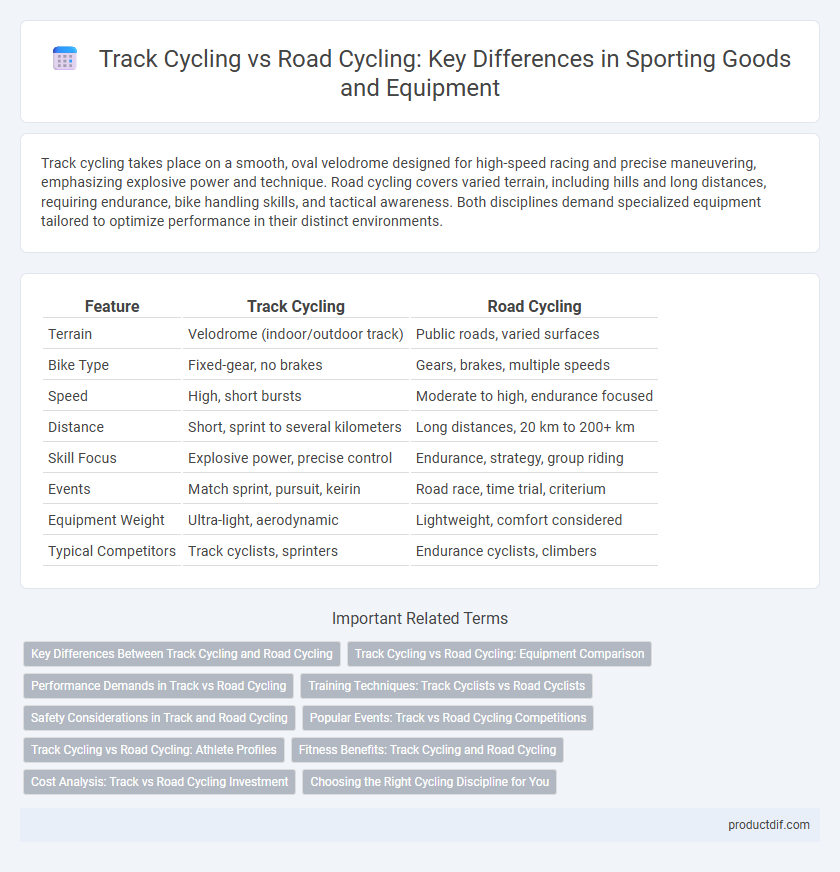Track cycling takes place on a smooth, oval velodrome designed for high-speed racing and precise maneuvering, emphasizing explosive power and technique. Road cycling covers varied terrain, including hills and long distances, requiring endurance, bike handling skills, and tactical awareness. Both disciplines demand specialized equipment tailored to optimize performance in their distinct environments.
Table of Comparison
| Feature | Track Cycling | Road Cycling |
|---|---|---|
| Terrain | Velodrome (indoor/outdoor track) | Public roads, varied surfaces |
| Bike Type | Fixed-gear, no brakes | Gears, brakes, multiple speeds |
| Speed | High, short bursts | Moderate to high, endurance focused |
| Distance | Short, sprint to several kilometers | Long distances, 20 km to 200+ km |
| Skill Focus | Explosive power, precise control | Endurance, strategy, group riding |
| Events | Match sprint, pursuit, keirin | Road race, time trial, criterium |
| Equipment Weight | Ultra-light, aerodynamic | Lightweight, comfort considered |
| Typical Competitors | Track cyclists, sprinters | Endurance cyclists, climbers |
Key Differences Between Track Cycling and Road Cycling
Track cycling takes place on a smooth, oval-shaped indoor velodrome with fixed-gear bikes designed for high speed and maneuverability, whereas road cycling occurs on varied outdoor terrains with geared bikes built for endurance and adaptability. Track cyclists use aerodynamic positions and specialized bikes without brakes to maximize speed on banked surfaces, while road cyclists face changing weather, road conditions, and elevation, requiring gear shifts and braking. The competitive formats also differ; track cycling features short, intense races like sprints and pursuits, whereas road cycling includes long-distance events, time trials, and stage races.
Track Cycling vs Road Cycling: Equipment Comparison
Track cycling requires a more aerodynamic and lightweight bike frame with a fixed gear and no brakes, designed for smooth velodrome surfaces, while road cycling bikes feature multiple gears, brakes, and durable tires suitable for varied terrains and longer distances. Track cycling wheels are typically deep-section or disc for reduced air resistance, whereas road cycling wheels balance aerodynamics and durability with tubeless or clincher tires for enhanced puncture resistance. Riders in track cycling prioritize stiffness and speed with minimalist setups, while road cycling emphasizes versatility, comfort, and control across diverse environments.
Performance Demands in Track vs Road Cycling
Track cycling demands explosive power and rapid acceleration due to its short, intense races on a smooth, banked velodrome, emphasizing anaerobic capacity and sprinting ability. Road cycling requires sustained endurance, aerobic capacity, and strategic energy management to navigate varied terrains and longer distances, often involving climbs and descents. Performance optimization in track cycling focuses on maximal power output and cadence, whereas road cycling prioritizes stamina, pacing, and efficient energy expenditure.
Training Techniques: Track Cyclists vs Road Cyclists
Track cyclists emphasize high-intensity interval training and explosive power development to enhance sprinting ability and maintain speed on a velodrome. Road cyclists prioritize endurance training with long-distance rides and varied terrain to build stamina and improve sustained performance during races. Both disciplines incorporate strength training but differ in specificity to match the unique demands of track and road cycling events.
Safety Considerations in Track and Road Cycling
Track cycling occurs in controlled environments with smooth surfaces and fewer hazards, reducing the risk of accidents compared to road cycling. Road cycling involves unpredictable traffic, varying road conditions, and potential obstacles, demanding heightened awareness and protective gear to ensure rider safety. Helmets, reflective clothing, and adherence to traffic laws are critical safety measures for both disciplines.
Popular Events: Track vs Road Cycling Competitions
Track cycling features high-intensity competitions like the UCI Track Cycling World Championships and the Six Day Series, held on velodromes with events such as the sprint, keirin, and team pursuit. Road cycling offers prestigious races including the Tour de France, Giro d'Italia, and Vuelta a Espana, emphasizing endurance and strategy over long distances and varying terrains. Both disciplines attract elite athletes and global audiences, showcasing distinct skills within competitive cycling sports.
Track Cycling vs Road Cycling: Athlete Profiles
Track cycling athletes exhibit explosive power and speed, excelling in short, intense races on velodromes that demand rapid acceleration and precise bike handling skills. Road cycling professionals demonstrate exceptional endurance and strategic pacing, navigating varied terrains and long distances that test stamina and adaptability. Both disciplines require specialized training regimens tailored to their unique physiological and tactical demands.
Fitness Benefits: Track Cycling and Road Cycling
Track cycling provides intense, short bursts of high-speed effort that improve anaerobic capacity, leg strength, and explosive power, making it ideal for enhancing sprint performance and muscle endurance. Road cycling offers extended aerobic workouts that boost cardiovascular health, stamina, and overall endurance by engaging large muscle groups over varied terrains and longer distances. Combining both disciplines can deliver comprehensive fitness benefits, balancing aerobic endurance with anaerobic power and muscular strength.
Cost Analysis: Track vs Road Cycling Investment
Track cycling typically requires a higher initial investment due to specialized indoor velodrome access and more expensive track-specific bikes, often ranging from $2,000 to $6,000. Road cycling costs vary depending on terrain and equipment, with entry-level road bikes starting around $800 and maintenance costs influenced by outdoor exposure and varied components. Both disciplines entail ongoing expenses, but track cycling's concentrated training environment may reduce travel and equipment replacement costs over time.
Choosing the Right Cycling Discipline for You
Track cycling emphasizes speed and precision on a smooth, banked velodrome, requiring a fixed-gear bike and intense bursts of power. Road cycling offers varied terrain and endurance challenges, using lightweight, multi-gear bicycles suited for long-distance riding on asphalt roads. Selecting the right discipline depends on your fitness goals, preferred training environment, and whether you favor explosive sprints or sustained endurance rides.
Track cycling vs Road cycling Infographic

 productdif.com
productdif.com